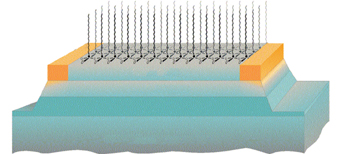The detector, called MOCSER (Molecular Controlled Semiconductor Resistor), is able to examine and identify tiny amounts of materials, up to only a few hundred molecules
 A tiny detector that uses organic molecules to examine various problems, from detecting an asthma attack to detecting the presence of explosives, was recently developed by a multidisciplinary team of scientists from the Weizmann Institute of Science: Prof. Ron Naaman from the Department of Chemical Physics, Prof. David Kahan from the Department of Materials Research and surfaces, and Prof. Avraham Schnitzer from the Department of Organic Chemistry.
A tiny detector that uses organic molecules to examine various problems, from detecting an asthma attack to detecting the presence of explosives, was recently developed by a multidisciplinary team of scientists from the Weizmann Institute of Science: Prof. Ron Naaman from the Department of Chemical Physics, Prof. David Kahan from the Department of Materials Research and surfaces, and Prof. Avraham Schnitzer from the Department of Organic Chemistry.
The detector, called MOCSER (Molecular Controlled Semiconductor Resistor), is able to examine and identify tiny amounts of substances, up to only a few hundred molecules. Detection of these small amounts may yield a lot of information. For example, detecting the level of nitrogen oxide in the air that a certain person breathes, may indicate that he is having an asthma attack. Identification of other molecules, which are included in the air that blows through a person's clothing, can show if he is carrying explosives under his clothes. Detecting the presence of nitric oxide in the brain can indicate certain types of damage or activity.
The scientists say that the use of the new detector to detect asthma attacks will also make it possible to diagnose the disease and predict attacks in the future. The part of the detector that detects nitrogen oxide is so small that 28 such detectors can be placed on an electronic chip. It is possible that by using different organic molecules, it will be possible to produce special detectors for detecting environmental pollutants, various prohibited substances, and biological molecules.
